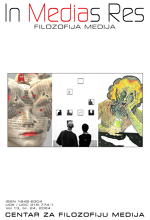Refrakcije religioznoga: boje i oblici bizantske umjetnosti na primjeru Eufrazijane
Refractions of the Religion: Colors and Shapes of Byzantine Art Applied to Euphrasian Basilica
Author(s): Dafne VidanecSubject(s): Visual Arts, Aesthetics, Ancient World, 6th to 12th Centuries, Sociology of Religion, History of Religion, History of Art
Published by: Centar za filozofiju medija i mediološka istraživanja
Keywords: Euphrasius basilica; Byzantium;mosaics; Martin Heidegger; ‘dialectic of the hand’; Hegel; refraction of spirit/ually in art;
Summary/Abstract: Euphrasius basilica (in Latin: Parentium, 6th c.), a remarkable monument of Byzantine art in the West represents hand-made artistic value expressed in colors and shapes that make illusion or mimetic acts related to the secrecy of the notable figures of the New Testament. Build specifically in the ritual purposes, and regarding its artistic and architectural expressions of the Christendom message (related mainly to the life of the Virgin Mary) , the Basilica’s mosaics reflects Martin Heidegger philosophical dialectics of the “thinking hand” (What is Called Thinking?). My thesis is that the mosaics of the Euphrasisus Basilica can be seen as ‘iconographic refractions’.
Journal: In Medias Res
- Issue Year: 13/2024
- Issue No: 24
- Page Range: 4049-4071
- Page Count: 23
- Language: Croatian

